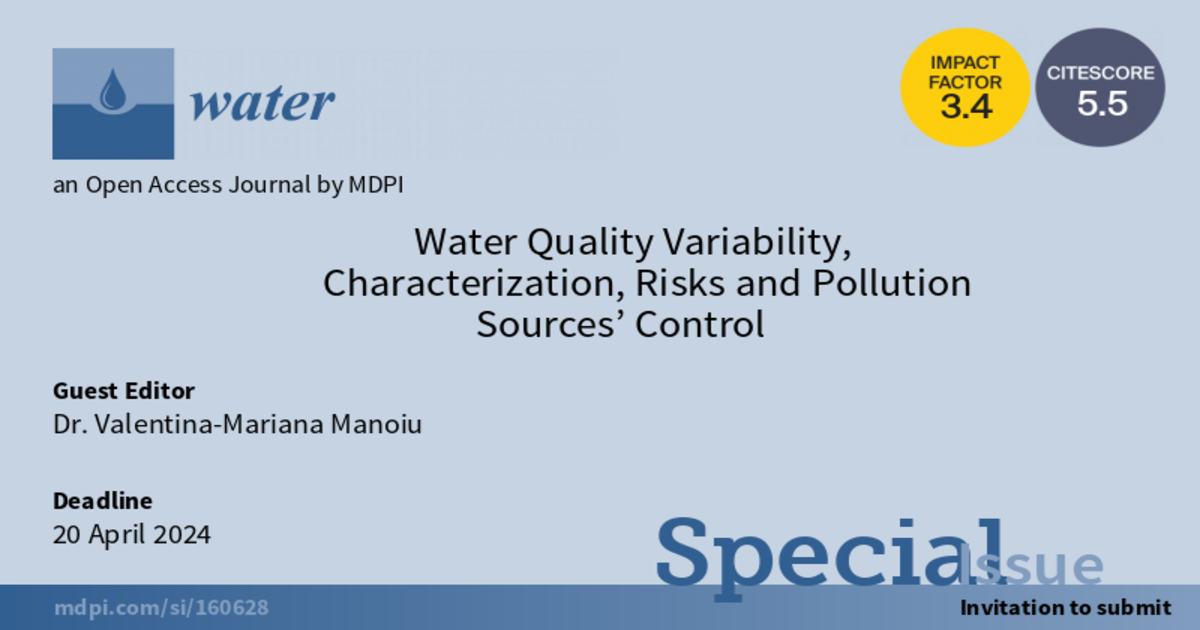Water Quality Variability, Characterization, Risks and Pollution Sources’ Control
A special issue of Water (ISSN 2073-4441). This special issue belongs to the section "Water Quality and Contamination".
Deadline for manuscript submissions: closed (20 April 2024) | Viewed by 2352

Special Issue Editor
Interests: environmental pollution and protection; water quality; air quality; environmental monitoring; waste management; environmental ethics; environmental education; climate change; veganism; biotechnology
Special Issues, Collections and Topics in MDPI journals
Special Issue Information
Dear Colleagues,
We are living difficult times that call for constant wise actions and solidarity, such as war, economic recession, hunger, water shortage, and different neglected environmental aspects. The global climate changes are already perturbing our lives, including freshwater availability. The human race’s activities, greed and recklessness have modified the quality of water resources, especially in the last 50 years, and the resultant pollution has affected most water bodies on the globe. It is necessary to carry out efficient water quality and pollution analysis and control, and to engage in risk management of low-quality water.
We invite you to apply your scientific experience in water quality through your scientific papers and contributions related to the topic of this Special Issue ,“Water Quality Variability, Characterization, Risks and Pollution Sources' Control”. The information gathered in this Issue could help many important ruling authorities, administrative bodies, governments, and political actors to enforce the best solutions and actions.
We welcome the submission of original research papers, reviews, case studies and theoretical/conceptualization works that highlight and analyze water quality management under the impact of human actions; water quality handling under the reality of climate change; water quality variability and characterization in different regions/countries and under different impacts; the impacts of different pollution sources on water quality and water pollution control; water quality monitoring systems under the burden of different economic activities in different contexts; effective technologies and policies that can mitigate the water pollution and its consequences; as well as best practices developed and best lessons learnt (narratives are also welcome) on the impacts of pollution on water quality.
We look forward to receiving your contributions until 1 November 2023!
Dr. Valentina-Mariana Manoiu
Guest Editor
Manuscript Submission Information
Manuscripts should be submitted online at www.mdpi.com by registering and logging in to this website. Once you are registered, click here to go to the submission form. Manuscripts can be submitted until the deadline. All submissions that pass pre-check are peer-reviewed. Accepted papers will be published continuously in the journal (as soon as accepted) and will be listed together on the special issue website. Research articles, review articles as well as short communications are invited. For planned papers, a title and short abstract (about 100 words) can be sent to the Editorial Office for announcement on this website.
Submitted manuscripts should not have been published previously, nor be under consideration for publication elsewhere (except conference proceedings papers). All manuscripts are thoroughly refereed through a single-blind peer-review process. A guide for authors and other relevant information for submission of manuscripts is available on the Instructions for Authors page. Water is an international peer-reviewed open access semimonthly journal published by MDPI.
Please visit the Instructions for Authors page before submitting a manuscript. The Article Processing Charge (APC) for publication in this open access journal is 2600 CHF (Swiss Francs). Submitted papers should be well formatted and use good English. Authors may use MDPI's English editing service prior to publication or during author revisions.
Keywords
- water quality
- water pollution
- control
- variability
- pollution risks
- human actions
- water monitoring





